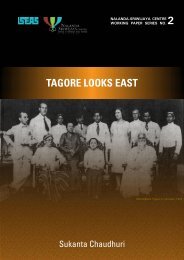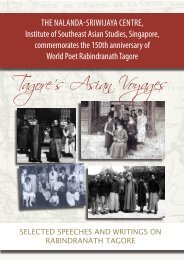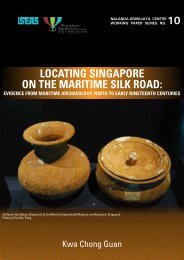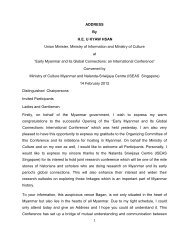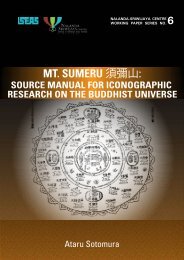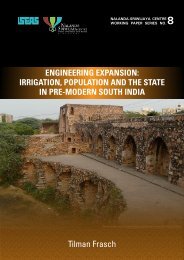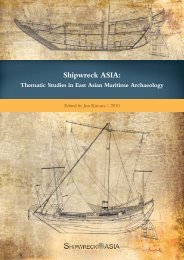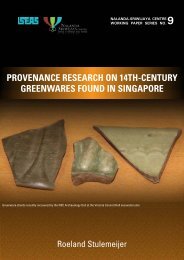Boni in Chinese Sources - Nalanda-Sriwijaya Centre - iseas
Boni in Chinese Sources - Nalanda-Sriwijaya Centre - iseas
Boni in Chinese Sources - Nalanda-Sriwijaya Centre - iseas
You also want an ePaper? Increase the reach of your titles
YUMPU automatically turns print PDFs into web optimized ePapers that Google loves.
Kurz: <strong>Boni</strong> <strong>in</strong> Ch<strong>in</strong>ese <strong>Sources</strong> NSC Work<strong>in</strong>g Paper No. 4com<strong>in</strong>g from the <strong>in</strong>cense burner <strong>in</strong>side the ma<strong>in</strong> hall of the temple. 38 Zhao does not sayanyth<strong>in</strong>g about the roof and its construction.It may thus not be completely wrong to accept that <strong>Boni</strong> had her own local religion withmany elements of Buddhism. This co<strong>in</strong>cides with the explanation Schafer gives for theadmiration of pearls <strong>in</strong> Tang Ch<strong>in</strong>a, where the pearl was a symbol of the Buddha and theBuddhist law. For Daoists, pearls were an important <strong>in</strong>gredient <strong>in</strong> life‐prolong<strong>in</strong>g drugs, butfor that purpose, they were gr<strong>in</strong>ded <strong>in</strong>to powder. Apart from that, pearls served asdecorations of dresses and furniture. 39 Thus Nicholl’s conclusion is not very conv<strong>in</strong>c<strong>in</strong>g afterall.Nicholl also makes much of the “more than hundred boats” that were the guard of the k<strong>in</strong>g,and sailed and controlled the coasts of northwestern Borneo. 40 The Ch<strong>in</strong>ese term for thevessel is too vague to warrant a translation as a sail<strong>in</strong>g ship, and the “more than hundred”maybe just an exaggeration to refer to many such boats.<strong>Boni</strong> 勃 泥 <strong>in</strong> the Institutions of the Song (Song huiyao 宋 會 要 )The works quoted above that are deal<strong>in</strong>g with <strong>Boni</strong> <strong>in</strong> such detail as the diplomatic missionsto Ch<strong>in</strong>a and the social and adm<strong>in</strong>istrative conditions can be regarded as one group of texts,while a second group of texts can be discerned that deal with the missions exclusively as apart of the foreign policy of the Song. These texts are merely <strong>in</strong>terested <strong>in</strong> list<strong>in</strong>g the dateswhen the missions arrived and their composition, and therefore, deliver not so much<strong>in</strong>formation on <strong>Boni</strong> itself.The Song huiyao 宋 会 要 may be recognized as the first of these works. Work on the Songhuiyao (“Institutions and documents of the Song”) started with the reign of emperorRenzong 仁 宗 (1023‐1063) and it is based on sources no longer available today, such as the38 Schipper, Taoist Body, 21.39 For the status of pearls <strong>in</strong> Tang Ch<strong>in</strong>a see Edward H. Schafer, The Golden Peaches of Samarkand: A Study ofT'ang Exotics (Berkeley: University of California Press, 1985), 242‐245.40 Nicholl, “An Age of Vicissitude”, 8.12





